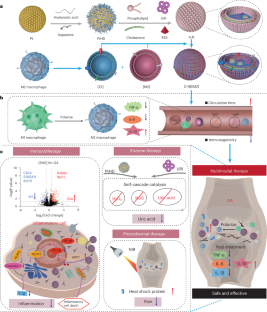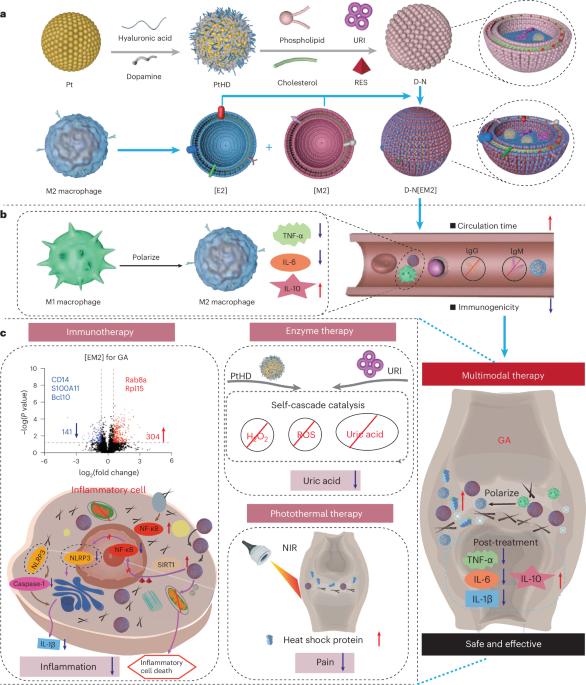Multimodal smart systems reprogramme macrophages and remove urate to treat gouty arthritis
IF 38.1
1区 材料科学
Q1 MATERIALS SCIENCE, MULTIDISCIPLINARY
引用次数: 0
Abstract
Gouty arthritis is a chronic and progressive disease characterized by high urate levels in the joints and by an inflammatory immune microenvironment. Clinical data indicate that urate reduction therapy or anti-inflammatory therapy alone often fails to deliver satisfactory outcomes. Here we have developed a smart biomimetic nanosystem featuring a ‘shell’ composed of a fusion membrane derived from M2 macrophages and exosomes, which encapsulates liposomes loaded with a combination of uricase, platinum-in-hyaluronan/polydopamine nanozyme and resveratrol. The nanosystem targets inflamed joints and promotes the accumulation of anti-inflammatory macrophages locally, while the uricase and the nanozyme reduce the levels of urate within the joints. Additionally, site-directed near-infrared irradiation provides localized mild thermotherapy through the action of platinum and polydopamine, initiating heat-induced tissue repair. Combined use of these components synergistically enhances overall outcomes, resulting in faster recovery of the damaged joint tissue. Gouty arthritis is an inflammatory arthritis characterized by high urate levels in the joints that is difficult to treat using standard therapies. Here the authors present a nano-enabled strategy that combines multiple lines of treatment for simultaneous reduction of urate levels and inflammation.


多模式智能系统重编程巨噬细胞并清除尿酸盐,治疗痛风性关节炎
痛风性关节炎是一种慢性进展性疾病,其特点是关节中尿酸盐含量高和免疫微环境发炎。临床数据表明,单纯的降低尿酸盐治疗或抗炎治疗往往无法取得令人满意的疗效。在此,我们开发了一种智能仿生纳米系统,其 "外壳 "由来自 M2 巨噬细胞和外泌体的融合膜组成,包裹着含有尿酸酶、透明质酸铂/多巴胺纳米酶和白藜芦醇的脂质体。纳米系统以发炎的关节为目标,促进抗炎巨噬细胞在局部聚集,而尿酸酶和纳米酶则降低关节内的尿酸盐含量。此外,定点近红外照射通过铂和多巴胺的作用提供局部温和热疗,启动热诱导组织修复。这些成分的联合使用可协同提高整体疗效,使受损关节组织更快恢复。
本文章由计算机程序翻译,如有差异,请以英文原文为准。
求助全文
约1分钟内获得全文
求助全文
来源期刊

Nature nanotechnology
工程技术-材料科学:综合
CiteScore
59.70
自引率
0.80%
发文量
196
审稿时长
4-8 weeks
期刊介绍:
Nature Nanotechnology is a prestigious journal that publishes high-quality papers in various areas of nanoscience and nanotechnology. The journal focuses on the design, characterization, and production of structures, devices, and systems that manipulate and control materials at atomic, molecular, and macromolecular scales. It encompasses both bottom-up and top-down approaches, as well as their combinations.
Furthermore, Nature Nanotechnology fosters the exchange of ideas among researchers from diverse disciplines such as chemistry, physics, material science, biomedical research, engineering, and more. It promotes collaboration at the forefront of this multidisciplinary field. The journal covers a wide range of topics, from fundamental research in physics, chemistry, and biology, including computational work and simulations, to the development of innovative devices and technologies for various industrial sectors such as information technology, medicine, manufacturing, high-performance materials, energy, and environmental technologies. It includes coverage of organic, inorganic, and hybrid materials.
 求助内容:
求助内容: 应助结果提醒方式:
应助结果提醒方式:


